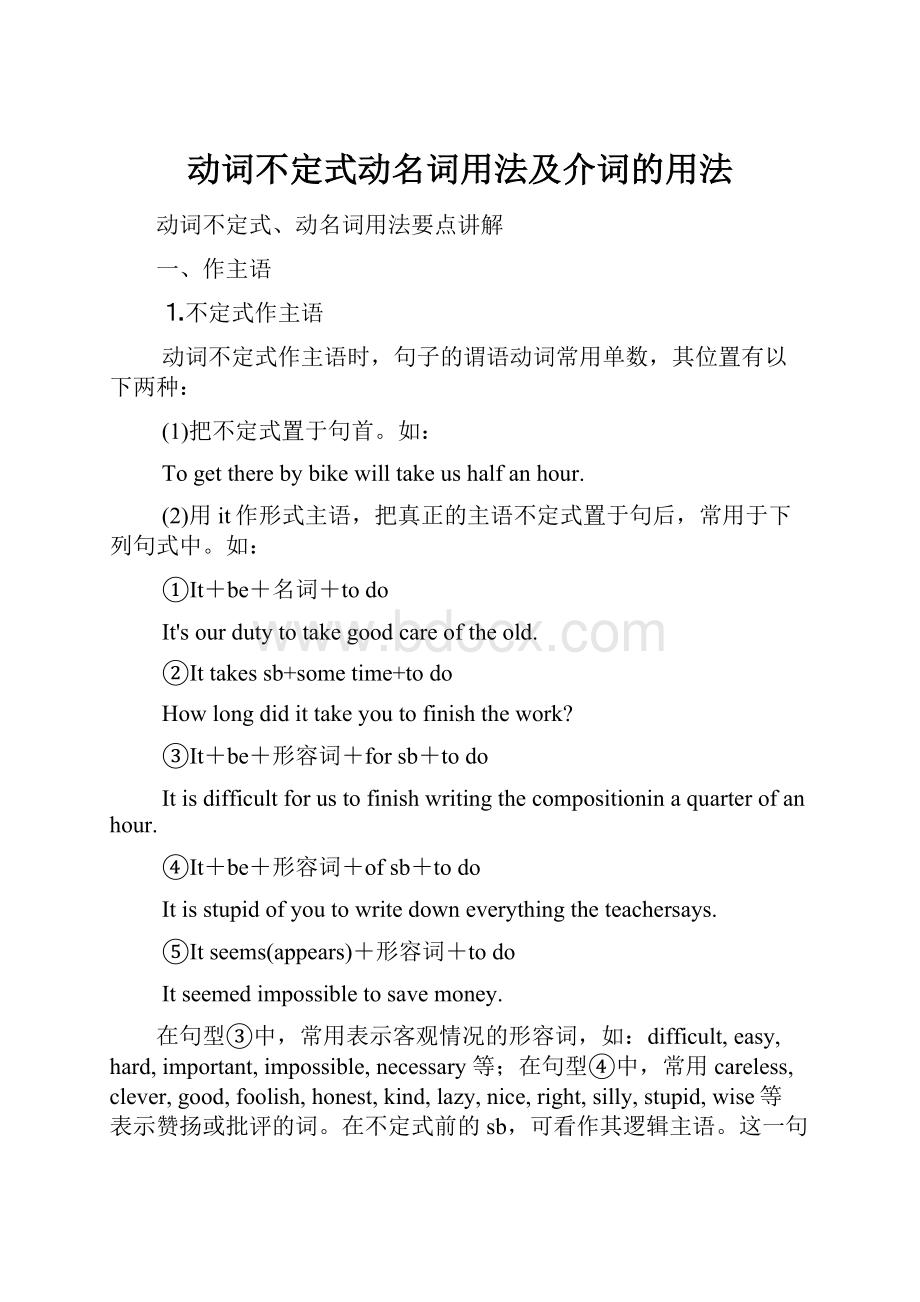动词不定式动名词用法及介词的用法.docx
《动词不定式动名词用法及介词的用法.docx》由会员分享,可在线阅读,更多相关《动词不定式动名词用法及介词的用法.docx(19页珍藏版)》请在冰豆网上搜索。

动词不定式动名词用法及介词的用法
动词不定式、动名词用法要点讲解
一、作主语
⒈不定式作主语
动词不定式作主语时,句子的谓语动词常用单数,其位置有以下两种:
(1)把不定式置于句首。
如:
Togettherebybikewilltakeushalfanhour.
(2)用it作形式主语,把真正的主语不定式置于句后,常用于下列句式中。
如:
①It+be+名词+todo
It'sourdutytotakegoodcareoftheold.
②Ittakessb+sometime+todo
Howlongdidittakeyoutofinishthework?
③It+be+形容词+forsb+todo
Itisdifficultforustofinishwritingthecompositioninaquarterofanhour.
④It+be+形容词+ofsb+todo
Itisstupidofyoutowritedowneverythingtheteachersays.
⑤Itseems(appears)+形容词+todo
Itseemedimpossibletosavemoney.
在句型③中,常用表示客观情况的形容词,如:
difficult,easy,hard,important,impossible,necessary等;在句型④中,常用careless,clever,good,foolish,honest,kind,lazy,nice,right,silly,stupid,wise等表示赞扬或批评的词。
在不定式前的sb,可看作其逻辑主语。
这一句式有时相当于Sbis+形容词+todo句式,如:
It'skindofyoutohelpmewithmyEnglish.=YouarekindtohelpmewithmyEnglish.
⒉动名词作主语
Learningwithoutpracticeisnogood.
动名词作主语时,也常用It句式。
如:
①It's+nogood(nouse,fun,apleasure,awasteoftime)+doing…
It'snogoodreadingindimlight.
It'snousesittingherewaiting.
②It's+形容词+doing
It'sdangerousswimmingintheseainwindydays.
这样用的形容词有expensive,nice,tiring等,但important,necessary则不适用于这种结构,应用不定式代替,如:
It'simportantforyoutokeepfit.
③Thereisno+doing
Thereisnosayingwhatwillhappennext.
在这一结构中,动名词后常带宾语,相当于"It'simpossibleto…"结构。
⒊动词不定式和动名词作主语的区别
①不定式作主语经常表示具体动作,常与特定的动作执行者联系在一起;而动名词作主语经常表示抽象动作,经常不与特定的动作执行者
联系在一起。
如:
It'snogoodeatingtoomuchfat.
It'snogoodforyoutoeatsomuchfat.
②动名词结构作主语,可以用名词或代词属格形式作逻辑主语。
如:
It'snouseyourpretendingthatyoudidn'tknowtherules.
二、作宾语
⒈不定式作宾语
①以下动词后,只能跟不定式作宾语。
如:
agree,ask,aim,arrange,choose,decide,demand,expect,fail,help,hope,lean,long,manage,offer,plan,prepare,pretend,promise,refuse,wish等,这些词大部分可接that引导的从句。
如:
Idecidedtoaskformymoneyback.
IdecidedthatIwouldaskformymoneyback.
Whenourvisittothefarmwasover,weexpectedtostartbackonfoot.
Whenourvisittothefarmwasover,weexpectedthatwewouldstartbackonfoot.
②当复合宾语中的宾语是不定式时,先用形式宾语it代替不定式,把不定式置于补语之后,即:
主语+动词+it+补语+todo句式。
如:
Wethinkitquiteimportantforustolearnaforeignlanguagewell.
Hefeelsithisdutytohelpthepoor.
③介词but,except,besides+todo(do)
在这种句型中,如介词前有动词do,后面应接不带to的不定式;如无do,则接to不定式,即带do不带to,带to不带do。
如:
Theenemysoldiershadnochoicebuttogivein.
OnSundayafternoonIhadnothingtodobutwatchTV.
⒉动名词作宾语
①以下动词后,只能接动名词作宾语,如:
admit,appreciate,consider,delay,enjoy,finish,keep,imagine,mind,miss,practise,resist,risk,save,suggest,don'tmind,giveup,insist,on,putoff等。
如:
Isuggestspendingoursummervacationinaseasidetown.
Youmustgiveupsmoking,foritdoestoomuchharmtoyourhealth.
②动名词作介词的宾语
Ishouldgotoattendthebirthdaycelebrationinsteadofstayingathome.
WhataboutinvitingLiJuntomakeaspeech?
动名词前的介词有时可以省略,如:
havedifficulty(in)doing,havenotrouble(in)doing,losenotime(in)doing,prevent/stop…(from)doing,thereisnouse(in)doing等。
⒊部分动词后面,既可接动词不定式,也可接动名词作宾语,意义不变。
如:
begin,continue,start,hate,like,love,need,require,want等。
在need,require,want后接-ing形式,表示被动意义,也可接不定式,但要用被动形式,如:
Yourhandwritingneedsimproving(tobeimproved).hate,love,like接不定式表示特定的未来事件,接动名词表示目前正在进行的活动或一般的行为。
在下列情况下,一般要用不定式:
①hate,like,love前有would(should)时,如:
I'dliketohaveacupofcoffee.
②当谓语动词begin,continue,start等是进行式时,如:
Thestudentsarestartingtoworkonthedifficultmathsproblem.
③begin,continue,start与know,understand等状态动词连用时,如:
Isoonbegantounderstandwhatwashappening.
⒋advise,allow,encourage,forbid,permit等动词后接动名词作宾语,或带不定式作宾语补足语。
如:
Ourteachersdon'tpermitourswimminginthelake.
Ourteachersdon'tpermitustoswiminthelake.
⒌部分动词后接不定式或动名词时,意义差别较大,应根据句子语境选择使用。
①forget,remember,regret后接不定式,表示现在或未来的动作,接动名词表示动作已经发生。
如:
Don'tforgetfoposttheletterforme.
HaveyouforgottenmeetingherinBeijingAirport?
Remembertoclosethewindowsbeforeyouleave.
Irememberwritinghimaletterayearago.
Weregrettotellyouthatallofyouarenotinvitedtoattendthemeeting.
Theyregrettedorderingthesebooksfromabroad.
②meantodo打算做某事
doing意味着……
Imeanttocatchupwiththeearlybus.
Thismeanswastingalotofmoney.
③trytodo设法尽力做某事
doing试着做某事
Youshouldtrytoovercomeyourshortcomings.
Tryworkingoutthephysicsprobleminanotherway.
④stoptodo停下一件事去做另一件事(不定式作目的状语)
doing停止做某事
Onthewaytotheairport,Istoppedtobuyapaper.
You'dbetterstoparguinganddoasyouaretold.
⑤can'thelpdoing禁不住……
todo不能帮助干……
Theycouldn'thelpjumpingupatthenews.
SorryIhavelotsofworktodo.SoIcan'thelptomakeuptheroomforyou.
⑥goontodo做不同的事或不同内容的事
doing继续不停地做某事,指同一动作的继续
Hewentontotalkaboutworldsituation.他接着又谈了世界形势。
We'llgoonfightingsolongasthereisoppressionintheworld.
⑦leaveofftodo离开某地去干什么(目的状语)
doing停下某事
It'stimetoleaveofftalkingandtostartacting.
Theyleftofftogofishing.
三、做表语
不定式作表语表示具体动作或将来动作;动名词作表语表示抽象的一般行为。
①Tobekindtotheenemyistobecrueltothepeople.
②Mychiefpurposeistopointoutthedifficultiesofthematter.
③WhatIwouldsuggestistoputoffthemeeting.
当主语和表语都是不定式时,其含义一是条件,一是结果(例①)。
当主语是aim,duty,hope,idea,mistake,plan,purpose,suggestion等为中心词的名词词组(例②)时,或以what引导的名词性分句(例③),不定式说明主语的内容。
④Ourworkisservingthepeople.
⑤Whathelikesistakingawalkaftersupper.
⑥ThestorytoldbyMr.Wangisinteresting.
④⑤句动名词作表语,与主语部分可以转换,如Servingthepeopleisoutwork,而⑥句中是现在分词作表语,说明主语的性质、状态,现在分词具有形容词的各种特征,另外,动名词作表语还应与进行时态区别开来。
四、作定语
⒈不定式作定语
不定式在句中作定语,置于被修饰的名词或代词之后。
如:
①ThenexttraintoarriveisfromWashington.
②Haveyouanythingtobetakentoyoursister?
③Doyouhaveanythingtosayonthequestion?
④Wouldyoupleasegivemesomepapertowriteon?
⑤MywishtovisitFrancehascometrueatlast.
不定式短语作定语和被修饰词之间表示以下关系:
(1)表示将来的动作(例①)。
(2)与被修饰词之间有动宾关系,如是不及物动词,则需加介词(例④)。
(3)与被修饰词之间有动宾关系,同时与句中其它词之间又有逻辑上的主谓关系时,尽管有被动含义,却仍用主动语态(例③);如只有动宾关系,而无逻辑上的主谓关系,则需用被动语态(例②)。
(4)不定式作定语时,一般可转换为定语从句,例①toarrive=thatwillarrive。
⒉动名词作定语
①Thispassagecanbeusedaslisteningmaterials.
②Thereadingroomofourschoollibrarycanhold800people.
③Allmovingbodieshaveenergy.
①②句动名词作定语说明一种性能,即:
用来……的;第③句为现在分词作定语,单个分词作定语常置于被修饰词之前,与被修饰词之间,可构成逻辑上的主谓关系,分词短语作定语常置于被修饰词之后。
如:
ThemanstandingattheschoolgateisProfessorHua.
五、不定式作补足语
⒈作宾语补足语
一些及物动词除要求按宾语外,有时还需要有宾语补足语,说明宾语的行为、状态、特征,这时意思才相对完整。
(1)常要求不定式作宾补的动词有:
allow,ask,advise,beg,cause,drive(强迫),encourage,expect,forbid,force,get,wouldlike(love,hate),order,permit,persuade,teach,tell,want,warn,wish等。
如:
①WouldyoulikemetogiveyourregardstoMary?
②Iwantyoutounderstandthewholepassageclearly.
(2)部分动词后常接tobe+形容词、名词短语等形式,有时tobe可省略,如:
believe,consider,discover,find(=consider),feel(=think),imagine,judge,know,prove,think,suppose,see(=understand),understand等。
①WeallbelieveJohn(tobe)honest.
②Iconsiderhim(tobe)oneofthebestbiologyteachersofNo.1MiddleSchool.
但当不定式是完成式时,to不能省略,如:
Weconsiderhimtohavebeenfoolish.
(3)感觉动词和使役动词后用作宾补的不定式须省略to。
①Ididn'thearanyonesayanythingaboutit.
②Theymakethestudentsdotoomuchhomeworkeveryday.
这种句式在变为被动语态时,to不能省略,如第②句:
Thestudentsaremadetodotoomuchhomeworkeveryday.
(4)help,know后面的"to"可有可无。
如:
Wouldyoupleasehelpme(to)fillinthetaxform?
I'veneverknownher(to)belatebefore.但:
HewasknowntohavebeentoFrancebefore.
(5)部分短语动词后,常接不定式作宾补,如:
Youmaydependonthemtobethereearly.
ThePartycallsonustoincreaseproductionandpractiseeconomy.
常这样用的短语动词有:
askfor,carefor,callon,counton,dependon,waitfor,longfor(渴望),preparefor,wishfor等。
⒉作主语补足语
不定式作主语补足语,和主语构成一种逻辑上的主谓关系。
如:
①Hewasnotallowedtoentertheclassroomforbeinglate.
②Theyounguniversitystudentisconsideredtohavegreatpromise.
六、不定式作状语
⒈作目的状语
(1)①Istayedtheretoseewhatwouldhappen.
②Henryhasdecidedtogotothehospitaltobeexaminedbythedoctor.
(2)有时为了强调,不定式前可加inorder或soas。
如:
Bobtookdownmytelephonenumbersoas(inorder)nottoforgetit.
有时为强调目的状语可把inorderto或不定式置于句首,但soasto不能这样用。
在这种句式中不定式部分可转换为sothat,inorderthat,成为目的状语从句,如:
Istayedtheresothat(inorderthat)Icouldseewhatwouldhappen.
(3)在部分表示感情色彩的形容词、过去分词或动词之后可接不定式,如:
astonished,glad,happy,laugh,pleased,sad,smile,sorry,surprised等。
①Wearegladtohearthenews.
②Iwassurprisedtoseethatathree-year-oldbabycouldwritesowell.
在部分形容词后接不定式,用主动形式表示被动意义,这种句型中的主语是不定式的逻辑宾语。
如:
Thequestionraisedbythestudentisdifficulttoanswer.
Theroomisreallycomfortabletolivein.
常这样用的形容词有:
comfortable,easy,dangerous,difficult,expensive,fit,impossible等。
⒉作结果状语
Wecamehomeafterourholidaytofindourgardenneatandtidy.
不定式作结果状语还常用在下列句式中。
如:
①so…asto;such…asto
I'mnotsostupid(afool)astoputitinwriting.我不至于愚蠢到会把它写下来。
I'mnotsuchastupidfoolastoputitinwriting.
②enough…to
Thespeedishighenoughforustocatchupwiththefirstliner.
③onlyto
Janehurriedbackonlytofindhermotherdyinginthehospital.
④too…to
I'mtootiredtostayuplonger.
但在下列结构中,too…to并非是“太……而不能……”之意。
如:
①I'monlytoogladtohavepassedtheexam.考试及格我太高兴了。
(too修饰gladtohave…,相当于very)
②Wehavetoomuchtolearn.我们要学的太多了(不定式作定语)。
⒊不定式短语还可作独立成分,用于句首、句中或句末。
如:
Totellthetruth,theplaywasagreatdisappointmenttome.
常见的短语有tobeexact(确切地说),tobeginwith(首先),todohimjustice(说句对他公道的话),tobesure(真的)等等。
七、动词不定式、动名词的其它用法
⒈疑问词+不定式结构
疑问词who,what,which,when,where,whether,how后可接不定式构成不定式短语,在句中作主语、宾语、表语等。
如:
①Whentoleavefor